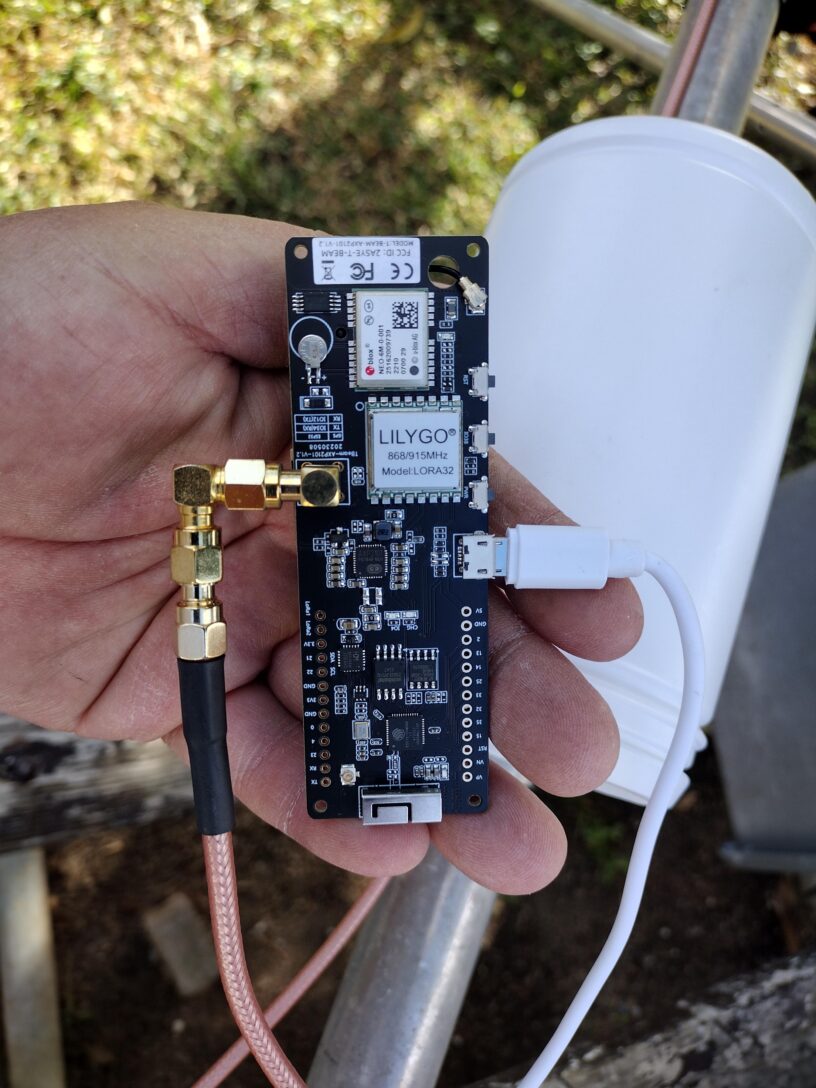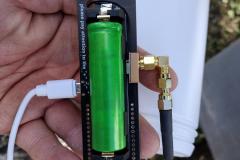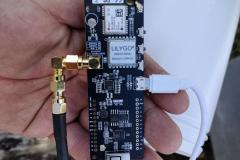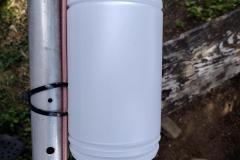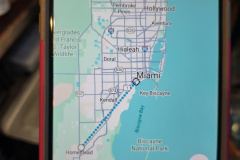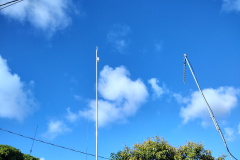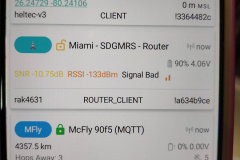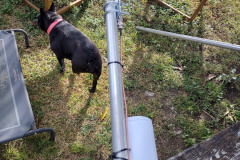If you’ve been monitoring our nets the last few weeks, you may have heard us talking about Meshtastic or mesh networking.
What is it?
Meshtastic is an open source wireless network that makes use of cheap, low power, license free devices to create an independent network capable of handling text messages and sensor data.
In the USA, the popular band for Meshtastic is the 900Mhz ISM license free band. As a ham you can use parts of the 900Mhz band and higher power transmitters BUT you give up the ability to run encryption, something even the cheapest mesh boards can do.
Wait? I can run encryption? YES! That’s part of the attraction to Meshtastic. It can run 256 bit encryption. The trade off is you’re limited to non-licensed power levels but with a high gain antenna and some height, impressive distances can be covered. In the pics there are some screenshots showing the contact log screen of the Meshtastic app and a google maps distance measurement. Signal was weak but that was 22 miles direct via RF from Homestead Fl to Downtown Miami. Granted the Downtown station is at 650′ and I’m at 25′ but still impressive for 100mw.
How do you program a device and interact with Meshtastic?
To put it in ultra simple terms… you flash the appropriate device with latest firmware on Mestastic website, you install the Meshtastic app on any compatible iOS or Android device, you connect via bluetooth to device and continue to configure from your cellphone or tablet. There’s plenty of tutorials, videos, and forums on how to set it up.
What can you do with it?
It’s mainly intended as a way to communicate via text in places where there is no cellphone of wifi. Basic sensor telemetry and GPS location can also be sent. It’s an option during a disaster as a way to communicate with neighbors, nearby family, SAR teams, etc.
Sounds too good to be true?
Well, it’s not without it’s caveats. Range is highly dependent on your station and those around you. Sitting the device on your dining room table with a little ducky antenna will produce poor results. Getting the device outside and elevating it or putting a high gain outdoor antenna on it will produce drastically better results. Height is might!
Why use this instead of voice?
Encryption and spread spectrum technology go a long way towards privacy and signal robustness. Receipt of message can be monitored. You can monitor multiple groups, encrypted and open. All devices (unless told not to) will pass traffic making the network more robust as more users come on board. The devices don’t care if traffic is encrypted or not, they don’t decode it and just pass it. Higher quality devices can do “store and forward” meaning they can wait till a good signal is heard to pass traffic.
How do you control your mesh setup?
A mesh station is called a node. You interact with the node using an iOS or Android phone or tablet. Once setup, you control all aspects of your node via wifi or bluetooth connection. You don’t necessarily need a connection to the web. You can be completely off web and still use a wifi router just for local access to your node to expand the distance between you and your mesh device much further than bluetooth will allow. For the computer geeks out there, there are ways to control web connected nodes from remote locations.
Can your mesh be linked to the web?
Yes. There’s a feature called MQTT that acts as a gateway between the mesh network and the web. While in MQTT mode your node will still interact with radio only nodes it can hear.
What’s the price of admission?
You can get started in Meshtastic for as little as $25 (at time of writing) for a Heltec V3 board with a ducky antenna. Add a case and internal battery and you’re at around $45. On the other end of the spectrum, you have devices that resemble a large 2 way pager with keyboard and high cap battery for around $150.
What if I want to contribute to making the network better?
For you tinkerers, Meshtastic has lots of opportunity. The same $25 Heltec board can be mounted in a weather proof enclosure, fed with solar power, connected to a high gain antenna, and mounted on a mast making it an asset to the network by increasing coverage for other folks.
Some lessons I learned while tinkering with my mesh node.
They start acting weird if voltage gets too low. They run on 5v USB or 3.7 lithium battery. Super long USB cables can present a problem due to voltage drop. If you’re running a wifi repeater, it can present an issue if your node sees two networks with same SSID at once and the one it was connected to drops off. It will stay there “confused” for a bit. If you power your node from a constant power source, get a $4 router re-booter from amazon. It cycles the power every 24hrs. I have found the re-booter to really be the secret sauce to making these things reliable. The buffer needs to get purged after a couple of days of heavy traffic.
Height is might but antenna feedline losses are worse. Keep your antenna cable lengths to the absolute minimum. Cable losses at 900mhz are quite pronounced. Ideally, the electronics should be at the base of the antenna in a weather proof box. I strongly recommend shielding said box by mounting it under an inverted opaque container. this will shield the electronics enclosure from direct sunlight and help curtail condensation at night.
Finally, do not power up node without an antenna. You will burn out the transmitter. Fortunately I didn’t have to experience this one but many have.
What’s in the pics attached to this post?
In closing, here’s what’s in the gallery pics for this post. The lilygo V1.1 board front/back with it’s 18650 battery holder, my makeshift rainproof enclosure, the whole station on a mast fed with a long USB cable for charging the 18650 off of solar, and screen shots of my 22 mile contact with that very same equipment.
